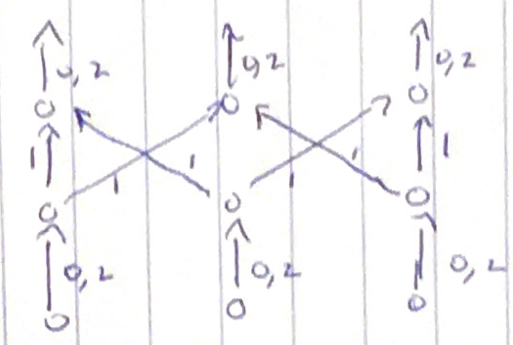Theorem 1. The problem is NP-hard.
Proof sketch. By reduction from maximum independent set in cubic graphs (which is NP-hard).
Given a cubic graph $G=(V, E)$, the reduction outputs a flow network as follows.
For every vertex $v\in V$, build the following gadget $g_v$:
Each edge in the bottom and top layers of $g_v$ has capacity 2 with the parity restriction that its flow be even, so it must have flow 0 or 2. Each edge in the middle layer has capacity 1. Note that *in any feasible integer flow (with the parity restriction), either all edges in $g_v$ are saturated, or all edges in $g_v$ have zero flow.
Now, for each edge $(u, w)$ in $G$, choose unique vertices $u_1$ and $w_1$ in the top layer of $g_u$ and $g_w$, respectively, and build the following NAND gadget $g_{uw}$ for edge $(u, w)$:
The gadget has new edges out of $u_1$ and $w_1$ going to a new middle vertex, and a new edge out of the new middle vertex into a new top vertex. All three new edges have capacity 2.
Each vertex $u$ in $G$ has degree three, so each of the three top nodes in $g_u$ is connected to exactly one edge gadget $g_{uw}$ for some $w$.
Now introduce a source $s$ with an edge to each bottom node of each vertex gadget, and a sink $t$ with an edge from each top node of each edge gadget. Give all the edges from $s$ and to $t$ capacity 2.
Now the feasible (parity-respecting) flows in this flow network correspond bijectively to independent sets in $G$, and this correspondence preserves size, in that the value of the flow is six times the size of its corresponding independent set. $~~~~\Box$



